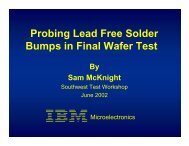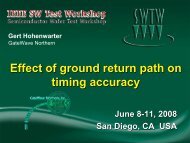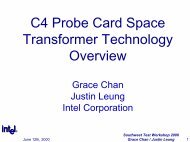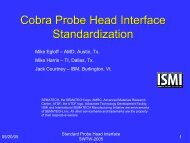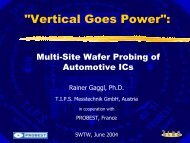Contacts for Flip Chip Wafer Level Probing - Semiconductor Wafer ...
Contacts for Flip Chip Wafer Level Probing - Semiconductor Wafer ...
Contacts for Flip Chip Wafer Level Probing - Semiconductor Wafer ...
Create successful ePaper yourself
Turn your PDF publications into a flip-book with our unique Google optimized e-Paper software.
June 12 to 15, 2011<br />
San Diego, CA<br />
Multi‐tip tip Probe (MtP) <strong>Contacts</strong> <strong>for</strong><br />
<strong>Flip</strong> <strong>Chip</strong> <strong>Wafer</strong> <strong>Level</strong> <strong>Probing</strong><br />
Norman Armendariz, Ph.D.<br />
norm@ti.com @i<br />
James Tong<br />
jtong@ti.com<br />
TEST TECHNOLOGY CENTER<br />
INFRASTRUCTURE
Overview<br />
• Introduction<br />
• Approach<br />
• Qualification Test Flows<br />
– Technology Qualification<br />
– Production Qualification<br />
• Effect of OT on CRes<br />
• Effect of Cleaning Frequency<br />
• Actual Over Travel<br />
• Comparative Analyses<br />
– Electrical<br />
– Mechanical<br />
• Summary of Multi‐tip Probe (MtP) Attributes<br />
• Conclusion<br />
• Acknowledgements<br />
June 12 to 15, 2011 IEEE SW Test Workshop 2
Introduction<br />
• Multi-site probing of <strong>Flip</strong> <strong>Chip</strong> devices with pin-counts<br />
approaching 12000 pins will physically strain the current<br />
mechanical test cell infrastructure capability and with<br />
increased electrical per<strong>for</strong>mance also required.<br />
• Currently, CVPC- conventional vertical probe cards are<br />
used to probe <strong>Flip</strong>-<strong>Chip</strong> devices (~170um pitch, 100um dia.<br />
solder bumps) w/~7000 pins.<br />
• The cost of probe cards are also expected to increase,<br />
primarily due to the need <strong>for</strong> custom interconnections.<br />
Typically, MLC-multi-layered substrates, are used to<br />
interconnect to the PCB.<br />
• Moreover, if these tips can leverage a similar MLC inherent<br />
to current FFI-Formfactor probe card construction, then a<br />
cost effective approach would also be facilitated.
Approach<br />
• A TI / FFI strategic probe development ef<strong>for</strong>t was initiated<br />
to MEMs fabricate probe tips on existing FFI MicroSpring®<br />
technology to validate the multi‐tip “probe physics” on<br />
solder bumped features.<br />
• A comparative analysis was then per<strong>for</strong>med to determine<br />
if a btt better probe solution, in terms of electrical land<br />
physical per<strong>for</strong>mance would result vs. current C‐VPC<br />
technology based on a test vehicle with ~4,000 spherical<br />
solder bumps at ~170um pitch.<br />
• Probe qualification and integration based on a 2‐step<br />
process;<br />
– 1‐Technology Qualification: to validate technology<br />
– 2‐Production Qualification: to determine production worthiness.
MtP / FFI-Micro-spring Probe Card Technology<br />
Micro Springs w/ MEMS used to <strong>for</strong>m “Crown” tips, similar to<br />
WSP pogo-pin crown-tips, may offer a better COO when<br />
scaling from x1 to x4 multi-site applications, since the MLCmulti-layered<br />
ceramic is inherent in both.<br />
Various crown tips or features can be custom fabricated on the<br />
Various crown tips or features can be custom fabricated on the<br />
micro-spring to optimize probing with the micro-springs<br />
fabricated on an MLC <strong>for</strong> multi-site.
QUALIFICATION TEST FLOW: MtP vs. C-VPC<br />
Dallas Test Floor<br />
TEST FLOORS<br />
Production<br />
Test Floor<br />
MtP/FFI<br />
MtP<br />
TECH<br />
QUAL<br />
PASS<br />
MtP<br />
PROD<br />
QUAL<br />
IN<br />
PROCESS<br />
MtP<br />
RTP<br />
STEP 1 NO STEP 2<br />
NO<br />
C-VPC WST<br />
SET-UP<br />
C-VPC WST<br />
TI-BASELINE<br />
C-VPC<br />
RTP<br />
Comparative probe card analysis per<strong>for</strong>med in parallel to CVPC to<br />
minimize risk to production delivery, if MtP did not work.
1‐Technology Qualification Test Flow<br />
Objective: Define a stable probe / cleaning process and<br />
HW set-up be<strong>for</strong>e volume production qualification phase.<br />
MtP Probe Cards<br />
Re-Probed<br />
#2<br />
8 <strong>Wafer</strong>s<br />
TestCell<br />
# 1<br />
MtP<br />
CARD 1<br />
<strong>Wafer</strong><br />
1<br />
<strong>Wafer</strong><br />
2<br />
MP MtP<br />
CARD 2<br />
<strong>Wafer</strong><br />
2<br />
<strong>Wafer</strong><br />
3<br />
<strong>Wafer</strong><br />
4<br />
Stop <strong>for</strong><br />
Tech Qual<br />
Review<br />
TestCell<br />
# 2<br />
CVPC<br />
CARD<br />
1<br />
Input Variables:<br />
<strong>Wafer</strong><br />
2<br />
• Probe Card to Probe Card<br />
• <strong>Wafer</strong> to <strong>Wafer</strong> (Re‐probe)<br />
<strong>Wafer</strong><br />
3<br />
Control Reference<br />
Output Variables:<br />
• CRes<br />
• Yield<br />
• Re‐Probe Rate<br />
• Throughput<br />
• Bump Scrub Damage<br />
• Planarity/Alignment
TQ: Effect of Over‐travel on CRes<br />
Better contact per<strong>for</strong>mance (low CRes) is observed as OTover‐travel<br />
increases, but minimum of 60um is needed to<br />
achieve a good stable contact.
TQ: Effect of Cleaning Freq. on CRes<br />
FT+45um<br />
Cleaning: 15PTds<br />
Stdev: 4.02<br />
Median: 24.90<br />
FT+55um<br />
Cleaning: 15PTds<br />
Stdev: 1.75<br />
Median: 24.38<br />
FT+60<br />
Cleaning: 15PTds<br />
Stdev: 0.59<br />
Median: 23.55<br />
FT+60um<br />
Cleaning: 100PTds<br />
Stdev: 0.68<br />
Median: 23.31<br />
FT+65um<br />
Cleaning: 15PTds<br />
Stdev: 0.92<br />
Median: 23.01<br />
FT+75um<br />
Cleaning: 15PTds<br />
Stdev: 0.47<br />
Median: 22.38<br />
No statistical difference was observed between 60 and 65 um over‐travel or<br />
between 15 and 100 PTds cleaning intervals, with the potential of further<br />
increasing this interval to further improves lifetime and test time.
TQ: Actual MtP Deflection in Test Cell<br />
AOT<br />
um<br />
Program Over-travel um (POT)<br />
– Programmed Over‐Travel<br />
(POT): The Z‐movement<br />
of the prober chuck in<br />
the z‐axis in the test cell.<br />
Dummy <strong>Wafer</strong><br />
Prober Chuck<br />
– Actual Over‐travel (AOT):<br />
The actual lZ‐movement /<br />
compression of the Multi<br />
Point Tip’s micro‐spring<br />
in the test cell.
Actual MtP Deflection in Test Cell<br />
• Based on the in‐situ “Clay Puck” tests, the actual overtravel<br />
(AOT) in the test cell was measured to be 40um<br />
with a POT of FT+100um.<br />
• In other words, a programmed over‐travel (POT) set at<br />
FT+100um is equivalent to 40um of actual over‐travel<br />
(AOT).<br />
• As a result, the current and stable programmed overtravel<br />
(POT) recipe was defined based on this<br />
characterization to within the capabilities of the MtP<br />
micro‐spring deflection range and with an effective<br />
lower <strong>for</strong>ce required than if 100um was the AOT.
TQ: MtP vs. CVPC Electrical Correlation<br />
C-VPC MtP #1<br />
<strong>Wafer</strong><br />
#1<br />
<strong>Wafer</strong><br />
#1<br />
MtP#2<br />
<strong>Wafer</strong><br />
#1<br />
Same wafer was probed with C‐VPC and both HD2’s cards<br />
MtP‐1 600/603 (99.5%) Bin to Bin correlation to C‐VPC<br />
MtP‐2 597/603 (99.2%) Bin to Bin correlation to C‐VPC
TQ: MtP vs. CVPC CRes Characterization<br />
22.5<br />
Multi-pt contact<br />
21.5<br />
20.5<br />
C-VPC<br />
Multi-pt<br />
Contact<br />
Stdev:<br />
0.12 ohms<br />
Median:<br />
22.14 ohms<br />
Stdev:<br />
0.43 ohms<br />
Median:<br />
20.64 ohms<br />
C-VPC<br />
Although the CVPC shows a lower CRes median, the CRes stability or STD is much<br />
tighter than the CVPC. The higher MtP value is attributed to the way CRes is<br />
measured, which is defined by the total path resistance of the MLC/PCB/HW.
2‐Production Qualification Test Flow<br />
Objective: To validate long term stability of probe card / setup<br />
and probe process reliability (Production Worthiness)<br />
MtP Probe Cards<br />
TestCell<br />
# 1<br />
Parallel Test Flow<br />
(Multi-Test Cell<br />
setups)<br />
MtP<br />
CARD<br />
1<br />
TestCell<br />
# 2<br />
LOTS<br />
1A,2A<br />
MtP<br />
CARD<br />
2<br />
LOTS<br />
3A,4A<br />
LOTs<br />
1B,2B<br />
LOTs<br />
3B,4B<br />
100 <strong>Wafer</strong>s<br />
Split 4 Lots<br />
RTP<br />
Input Variables:<br />
• Probe Card to Probe Card<br />
• <strong>Wafer</strong> to <strong>Wafer</strong> (Re‐probe)<br />
• Lot to Lot<br />
Output Variables:<br />
• CRes<br />
• Yield<br />
• Re‐Probe Rate<br />
• TPT<br />
• Bump Scrub Damage<br />
• Planarity/Alignment<br />
• Lifetime/Reliability
PQ: MtP Production CRes Stability<br />
Test Cell A<br />
Test Cell B<br />
Test Cell C<br />
Lot#4<br />
Lot#1 Lot#2 Lot#3<br />
Continuous production lots ran during production qualification checkout<br />
demonstrated contact stability over many consecutive wafers probed. This<br />
validated the process recipe stability and margin <strong>for</strong> production fan out.
PQ: MtP Electrical Test Reliability<br />
‐Re‐probe rate is very low w/ an average of 0.12% out of 40K die probed.<br />
‐Yield recovery from re‐probe related to contact was extremely low.<br />
‐Implies: mis‐contact is negligible and 1st Pass Yield is maximized
C‐VPC vs. MtP: Effect on Bump<br />
C-VPC Flat probes<br />
MtP<br />
MtP<br />
CVPC Flat probes compress or<br />
impact the apex of the bump.<br />
Multi‐tip contacts create small<br />
dimple marks away from the apex<br />
Bump height damage > 1/3 of of bump; not affecting bump<br />
the bump is not desirable. Also, height. The pointed tips better<br />
CRes not as stable thus, more penetrate the bump’s oxide layer,<br />
frequent cleaning to remove resulting in stable CRes using<br />
compacted debris is required.<br />
much lower probe <strong>for</strong>ce.
Key Learning: “Probe Physics”<br />
• The pressure between any two (2) surfaces in<br />
contact with each other is a function of <strong>for</strong>ce<br />
and contact area.<br />
Force = Pressure x Contact Area<br />
• Multi‐Point tip enables a lower <strong>for</strong>ce per<br />
probe creating adequate pressure to break<br />
into the surface of the bump to make a<br />
reliable electrical contact.<br />
• To achieve the same effect, the<br />
corresponding flat tip of a C‐VPC approach<br />
would requires a larger <strong>for</strong>ce to collapse the<br />
surface oxide of the bump apex<br />
• The electrical contact surface area; however<br />
is comparable where the sides of the<br />
pyramid provide po desufficient surface aea area <strong>for</strong><br />
electrical conduction.<br />
Area 1<br />
Flat Tip<br />
C-VPC<br />
Area 2<br />
Multi-<br />
Point<br />
Contact
Summary of MTP Attributes<br />
• Self alignment of tips to<br />
bump. Well centered<br />
• No reflow of bump after<br />
probe is required<br />
• CRes < C‐VPC<br />
• Force/Pin < C‐VPC<br />
• Cleaning < C‐VPC<br />
• Planarization not required<br />
• Cost Of Ownership < C‐VPC<br />
(Multi‐Site)
Conclusion<br />
• Multi-tip Probe contacts with the “piercing” action,<br />
demonstrated a stable and production worthy contact<br />
mechanism <strong>for</strong> <strong>Flip</strong> <strong>Chip</strong> bump probing using a lower<br />
<strong>for</strong>ce solution than the C-VPC<br />
• The lower <strong>for</strong>ce exhibited by the MtP probe enables a<br />
path <strong>for</strong> a viable high pin-count / multi-site configurations<br />
probe solution with a lower Cost Of Ownership (COO)<br />
• When this technology successfully completes the<br />
Production Qualification phase and if meets TI COO<br />
targets, then it will be deployed to test floors as<br />
production volumes warrant.
Acknowledgements<br />
•Carey Farley<br />
•Dien Ho<br />
•Stan Ferrell<br />
•Dan Stillman<br />
•Jim Oborny<br />
•Frank Meza<br />
•Tim Lillie<br />
•Doug Shuey<br />
•Barry Naseck


